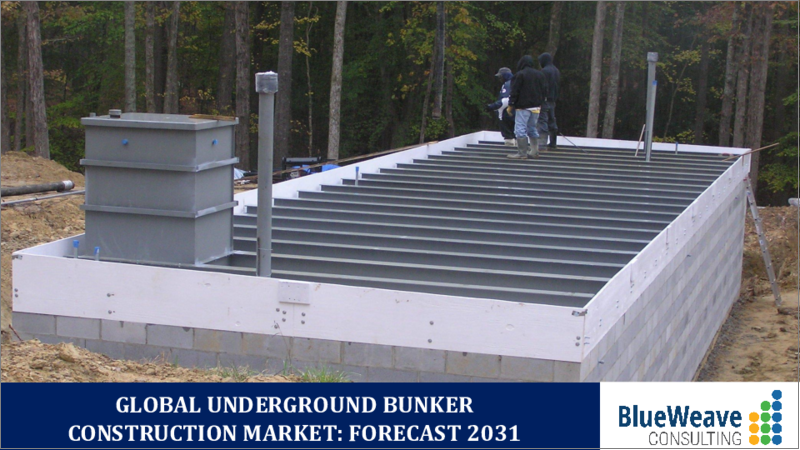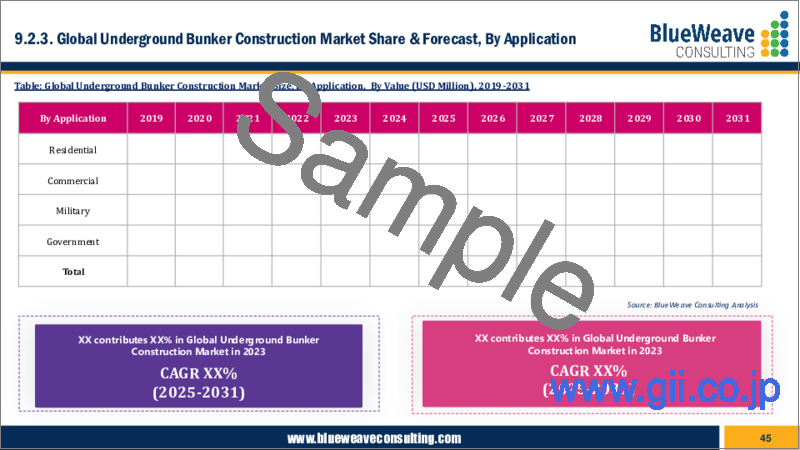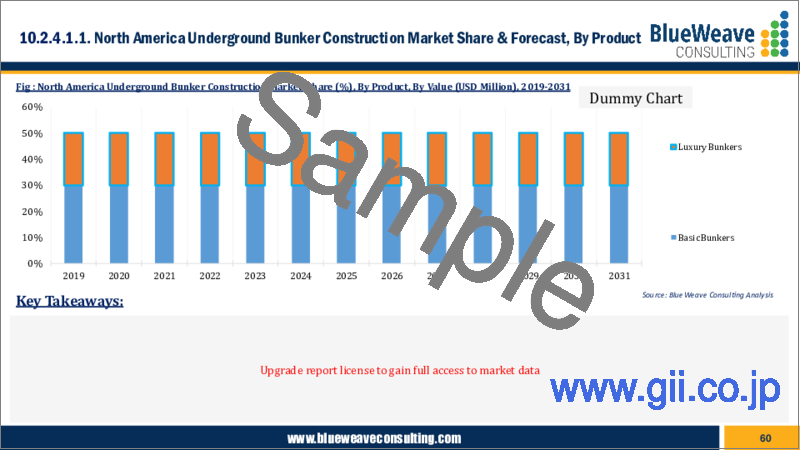|
|
市場調査レポート
商品コード
1500664
地下バンカー建設市場- 世界の規模、シェア、動向分析、機会、予測レポート、2019-2030年Underground Bunker Construction Market - Global Size, Share, Trend Analysis, Opportunity and Forecast Report, 2019-2030, Segmented By Product; By Size; By Application; By Region |
||||||
|
|||||||
| 地下バンカー建設市場- 世界の規模、シェア、動向分析、機会、予測レポート、2019-2030年 |
|
出版日: 2024年05月21日
発行: Blueweave Consulting
ページ情報: 英文 400 Pages
納期: 2~3営業日
|
全表示
- 概要
- 目次
地下バンカー建設の世界市場規模は2030年までに367億米ドルに達する大幅なCAGRで急成長
世界の地下バンカー建設市場は、世界の脅威に対する認識の高まり、貧富の格差と安全保障上の懸念の増大、マーケティングとメディアの影響力、生存主義と備え文化の台頭により、活況を呈しています。
大手戦略コンサルティング・市場調査会社のBlueWeave Consultingは最近の調査で、2023年の地下バンカー建設の世界市場規模を231億2,000万米ドルと推定しました。2024年から2030年にかけての予測期間中、BlueWeaveは地下バンカー建設の世界市場規模がCAGR 9.85%で拡大し、2030年には366億6,000万米ドルに達すると予測しています。世界の地下バンカー建設市場は、世界の不確実性の増大、地政学的紛争、緊急事態への備えの重視の高まりによって推進されています。政府、企業、個人は、自然災害や人災のような脅威から身を守るため、地下壕の建設やアップグレードをますます進めています。建築材料、換気、持続可能エネルギーにおける技術的進歩が、この市場の将来を牽引すると予想されます。さらに、洗練されたセキュリティ・システムや高度な通信ネットワークなどのスマート技術が、バンカーの設計で一般的になりつつあります。気候変動への懸念が高まる中、環境に優しくエネルギー効率の高いシェルター設計へのシフトが進んでいます。市場は世界的に拡大しているが、規制への対応、コスト管理、社会的認知度といった課題に直面しています。まとめると、地下バンカーとシェルターの市場は、技術革新、持続可能性、包括的な緊急時対策に焦点を当てながら、成長すると思われます。
地政学的緊張の高まりが世界の地下バンカー建設市場に与える影響
地政学的緊張の高まりは、世界の地下バンカー建設市場の需要を促進すると同時に、重大な課題を提示しています。国家安全保障、核の脅威、社会の不安定化に対する懸念が高まる中、政府も民間団体も身を守る手段として地下バンカーに投資しています。これらの堅牢な構造物は、さまざまな災害に耐えられるように設計されており、安全を求めている人々に安全なシェルターと保管庫を提供しています。個人、企業、政府が紛争や自然災害によるリスクの軽減を求めており、官民を問わず需要があります。例えば、ウクライナのクリヴィイ・リでは、製鉄所で働く労働者たちが、鉱山機械の生産から前線部隊用の金属製バンカーの建設へとシフトしています。この再利用は、現在進行中のロシアの侵攻に促されたもので、紛争地帯における安全性と備えの緊急の必要性を浮き彫りにしています。約2トンの鋼鉄で作られ、地下に埋められるように設計された掩体壕は、重砲にも耐え、最大6人の兵士が宿泊できます。木製のベッド、収納スペース、ストーブなどの機能を備え、実用的なシェルターとして機能します。メティンベストの構想はソ連時代の設計を使用しており、地政学的対立がバンカー市場に与える影響を強めています。地下壕建設へのこのようなシフトは、世界の不安定性の高まりを背景とした、安全性と回復力を求める広範な動向を示しています。
世界の地下バンカー建設市場
セグメント別情報
地下バンカー建設の世界市場:製品別
製品別に見ると、地下バンカーの世界市場は基本バンカーと高級バンカーに二分されます。地下バンカー建設の世界市場において、製品別では高級品セグメントのシェアが高いです。これは主に、総合的な安全性と快適性を求める超富裕層からの需要が増加しているためです。これらのバンカーは、プール、ジム、デザイナー家具、防音壁などの高級アメニティを提供するように設計されており、安全性だけでなく贅沢なライフスタイルを提供します。富裕層の顧客は、社会不安や自然災害、経済破綻への懸念から、高級なセキュリティ・ソリューションに投資することが多いです。高級バンカーは、自律的なエネルギー生成、高度な空気濾過、食糧生産などの機能によって長期的な自給自足を提供する能力を備えており、贅沢な生活水準を維持しながら資産と個人の安全を守ろうとするこの層をさらに惹きつけています。
地下バンカー建設の世界市場- 地域別
この調査レポートは、世界の地下バンカー建設市場を5地域にわたって調査・分析した報告書です:北米、欧州、アジア太平洋、ラテンアメリカ、中東アフリカの5地域です。北米と欧州は地下バンカー建設の世界市場で最も高いシェアを占めており、予測期間中もその優位性を維持すると予測されています。この優位性は、国際紛争への歴史的関与、このような多額の投資を可能にする可処分所得の高さ、安全な地下施設を建設するための既存のインフラなど、さまざまな要因が重なっていることに起因しています。また、バンカー建設におけるスイスの長年の専門知識は「ゴールド・スタンダード」となり、世界の注目を集めています。冷戦時代から、核の脅威を恐れて地下に大規模な防空壕を建設してきたスイスの防空壕の数は37万を超え、そのカバー率は107%に達しています。このようなインフラは、他の欧州諸国にも同様の強固なバンカーを開発させるきっかけとなった。バンカーの技術とノウハウを輸出したスイスは、その地位を確固たるものとし、市場の成長を牽引しています。さらに、欧州の政治的安定と経済力が地下建設への多額の投資を可能にし、バンカーの持続的な需要を促進しています。
競合情勢
世界の地下バンカー建設市場は細分化されており、多数の企業が市場に参入しています。世界の地下バンカー建設市場を独占している主要企業は、Atlas Survival Shelters、Vivos、Rising S Company、Subterranean Structures、Blastcrete Industries、Oppidum、Highland Engineering、Drbteq、Nelson Engineering、Koru Undergroundなどです。各企業が採用する主なマーケティング戦略は、施設拡大、製品の多様化、提携、協力、パートナーシップ、買収などで、顧客リーチを拡大し、市場全体における競争力を獲得しています。
本レポートの詳細な分析により、成長の可能性、今後の動向、世界の地下バンカー建設市場の統計に関する情報を提供します。また、総市場規模の予測を促進する要因も取り上げています。当レポートは、意思決定者が健全な戦略的意思決定を行うのに役立つ業界洞察とともに、世界の地下バンカー建設市場の最新技術動向を提供することをお約束します。さらに、市場の成長促進要因・課題・競争力についても分析しています。
目次
第1章 調査の枠組み
第2章 エグゼクティブサマリー
第3章 世界の地下バンカー建設市場の洞察
- 業界バリューチェーン分析
- DROC分析
- 成長促進要因
- 世界の脅威に対する認識の高まり
- 富の格差と安全保障上の懸念
- マーケティングとメディアの影響
- サバイバル主義と備えの文化の台頭
- 抑制要因
- 高コスト
- メンテナンス要件
- 機会
- 投資の可能性
- 技術の進歩
- 課題
- 規制上のハードル
- 再販の可能性は限られている
- 成長促進要因
- 技術の進歩/最近の動向
- 規制の枠組み
- ポーターのファイブフォース分析
第4章 世界の地下バンカー建設市場:マーケティング戦略
第5章 世界の地下バンカー建設市場:価格分析
第6章 世界の地下バンカー建設市場:地域分析
- 世界の地下バンカー建設市場、地域分析、2023年
- 世界の地下バンカー建設市場、市場の魅力分析、2024-2030年
第7章 世界の地下バンカー建設市場概要
- 市場規模と予測、2019-2030年
- 金額別
- 市場シェアと予測
- 製品別
- 基本的なバンカー
- 高級バンカー
- サイズ別
- コンパクトバンカー
- 中型バンカー
- 大型バンカー
- 用途別
- 住宅
- 商用
- 軍隊
- 政府
- 地域別
- 北米
- 欧州
- アジア太平洋
- ラテンアメリカ
- 中東およびアフリカ
- 製品別
第8章 北米の地下バンカー建設市場
- 市場規模と予測、2019-2030年
- 金額別
- 市場シェアと予測
- 製品別
- サイズ別
- 用途別
- 国別
- 米国
- カナダ
第9章 欧州の地下バンカー建設市場
- 市場規模と予測、2019-2030年
- 金額別
- 市場シェアと予測
- 製品別
- サイズ別
- 用途別
- 国別
- ドイツ
- 英国
- イタリア
- フランス
- スペイン
- ベルギー
- ロシア
- オランダ
- その他欧州
第10章 アジア太平洋地域の地下バンカー建設市場
- 市場規模と予測、2019-2030年
- 金額別
- 市場シェアと予測
- 製品別
- サイズ別
- 用途別
- 国別
- 中国
- インド
- 日本
- 韓国
- オーストラリアとニュージーランド
- インドネシア
- マレーシア
- シンガポール
- ベトナム
- アジア太平洋のその他諸国
第11章 ラテンアメリカの地下バンカー建設市場
- 市場規模と予測、2019-2030年
- 金額別
- 市場シェアと予測
- 製品別
- サイズ別
- 用途別
- 国別
- ブラジル
- メキシコ
- アルゼンチン
- ペルー
- その他のラテンアメリカ
第12章 中東・アフリカの地下バンカー建設市場
- 市場規模と予測、2019-2030年
- 金額別
- 市場シェアと予測
- 製品別
- サイズ別
- 用途別
- 国別
- サウジアラビア
- アラブ首長国連邦
- カタール
- クウェート
- 南アフリカ
- ナイジェリア
- アルジェリア
- 中東・アフリカのその他
第13章 競合情勢
- 主要企業とその提供内容のリスト
- 世界の地下バンカー建設企業の市場シェア分析、2023年
- 経営パラメータによる競合ベンチマーキング
- 主要な戦略的展開(合併、買収、提携など)
第14章 地政学的緊張の高まりが世界の地下バンカー建設市場に与える影響
第15章 企業プロファイル(会社概要、財務マトリックス、競合情勢、主要人物、主要競合、連絡先、戦略展望、 SWOT分析)
- Atlas Survival Shelters
- Vivos
- Rising S Company
- Subterranean Structures
- Blastcrete Industries
- Oppidum
- Highland Engineering
- Drbteq
- Nelson Engineering
- Koru Underground
- その他の主要企業
第16章 主要な戦略的提言
第17章 調査手法
Global Underground Bunker Construction Market Size Booming at Significant CAGR to Touch USD 36.7 Billion by 2030
Global Underground Bunker Construction Market is flourishing due to an increasing perception of global threats, growing wealth disparity and security concerns, marketing and media influence, and rising of survivalism and preparedness culture.
BlueWeave Consulting, a leading strategic consulting and market research firm, in its recent study, estimated the Global Underground Bunker Construction Market size at USD 23.12 billion in 2023. During the forecast period between 2024 and 2030, BlueWeave expects the Global Underground Bunker Construction Market size to expand at a CAGR of 9.85% reaching a value of USD 36.66 billion by 2030. The Global Underground Bunker Construction Market is propelled by the growing global uncertainties, geopolitical conflicts, and a heightened emphasis on emergency preparedness. Governments, companies, and individuals are increasingly building or upgrading bunkers to safeguard against threats like natural disasters and man-made crises. Technological advances in construction materials, ventilation, and sustainable energy are expected to drive the future of this market. Additionally, smart technologies such as sophisticated security systems and advanced communication networks are becoming more common in bunker design. With growing concerns about climate change, there's a shift towards eco-friendly and energy-efficient shelter designs. Although the market is expanding worldwide, it faces challenges such as regulatory compliance, cost management, and public awareness. In summary, the market for underground bunkers and shelters is set to grow, with a focus on innovation, sustainability, and comprehensive emergency preparedness.
Impact of Escalating Geopolitical Tensions on Global Underground Bunker Construction Market
Escalating geopolitical tensions are presenting significant challenges while also driving demand in the Global Underground Bunker Construction Market. With increasing concerns about national security, nuclear threats, and societal instability, both governments and private entities are investing in underground bunkers as a means of protection. These robust structures are designed to withstand a range of disasters, offering secure shelter and storage for those seeking safety. The demand comes from public and private sectors alike, with individuals, corporations, and governments seeking to mitigate risks from conflicts and natural disasters. For instance, Ukraine's Kryvyi Rih, where workers at a steel plant are shifting from mining equipment production to building metal bunkers for front-line troops. This repurposing, prompted by Russia's ongoing invasion, highlights the urgent need for safety and preparedness in conflict zones. The bunkers, constructed from nearly two tons of steel and designed to be buried underground, can withstand heavy artillery and provide accommodations for up to six soldiers. With features like wooden beds, storage space, and stoves, they serve as practical shelters. Metinvest's initiative uses Soviet-era designs, reinforcing the influence of geopolitical conflicts on the bunker market. This shift towards bunker construction indicates a broader trend toward security and resilience, driven by growing global instability.
Global Underground Bunker Construction Market
Segmental Information
Global Underground Bunker Construction Market - By Product
By product, the Global Underground Bunker Construction Market is bifurcated into Basic Bunkers and Luxury Bunkers segments. The luxury segment holds a higher share in the Global Underground Bunker Construction Market by product. It is primarily due to the rise in demand from ultra-wealthy individuals seeking comprehensive safety and comfort. These bunkers are designed to provide high-end amenities, such as pools, gyms, designer furniture, and soundproof walls, offering not just security but a luxurious lifestyle. The affluent clientele are often motivated by concerns about societal unrest, natural disasters, or economic collapse, leading them to invest in premium security solutions. The luxury bunkers' capacity to offer long-term self-sufficiency with features like autonomous energy generation, advanced air filtration, and food production further attracts this demographic, who seek to safeguard their assets and personal safety while maintaining a luxurious standard of living.
Global Underground Bunker Construction Market - By Region
The in-depth research report on the Global Underground Bunker Construction Market covers the market in a number of major countries across five regions: North America, Europe, Asia Pacific, Latin America, and Middle East and Africa. North America and Europe hold the highest shares in the Global Underground Bunker Construction Market and are expected to maintain their dominance during the forecast period. The dominance stems from a confluence of factors including historical involvement in international conflicts, higher disposable income allowing for such significant investments, and a pre-existing infrastructure for building secure underground facilities. Also, Switzerland's long-standing expertise in bunker construction sets a "gold standard," attracting global attention. Since the Cold War, the country has built extensive underground bomb shelters, influenced by fears of nuclear threats, leading to over 370,000 shelters with a 107% coverage rate. This infrastructure has inspired other European countries to develop similar robust bunkers. Switzerland's export of bunker technology and know-how has cemented its position, driving market growth. Additionally, Europe's political stability and economic strength enable substantial investments in underground construction, fostering sustained demand for bunkers.
Competitive Landscape
The Global Underground Bunker Construction Market is fragmented, with numerous players serving the market. The key players dominating the Global Underground Bunker Construction Market include Atlas Survival Shelters, Vivos, Rising S Company, Subterranean Structures, Blastcrete Industries, Oppidum, Highland Engineering, Drbteq, Nelson Engineering, and Koru Underground. The key marketing strategies adopted by the players are facility expansion, product diversification, alliances, collaborations, partnerships, and acquisitions to expand their customer reach and gain a competitive edge in the overall market.
The report's in-depth analysis provides information about growth potential, upcoming trends, and the Global Underground Bunker Construction Market statistics. It also highlights the factors driving forecasts of total market size. The report promises to provide recent technology trends in the Global Underground Bunker Construction Market along with industry insights to help decision-makers make sound strategic decisions. Furthermore, the report also analyses the growth drivers, challenges, and competitive dynamics of the market.
Table of Contents
1. Research Framework
- 1.1. Research Objective
- 1.2. Product Overview
- 1.3. Market Segmentation
2. Executive Summary
3. Global Underground Bunker Construction Market Insights
- 3.1. Industry Value Chain Analysis
- 3.2. DROC Analysis
- 3.2.1. Growth Drivers
- 3.2.1.1. Increasing perception of global threats
- 3.2.1.2. Wealth disparity and security concerns
- 3.2.1.3. Marketing and media influence
- 3.2.1.4. Rise of survivalism and preparedness culture
- 3.2.2. Restraints
- 3.2.2.1. High Costs
- 3.2.2.2. Maintenance requirements
- 3.2.3. Opportunities
- 3.2.3.1. Investment potential
- 3.2.3.2. Advancement in technology
- 3.2.4. Challenges
- 3.2.4.1. Regulatory hurdles
- 3.2.4.2. Limited resale potential
- 3.2.1. Growth Drivers
- 3.3. Technological Advancements/Recent Developments
- 3.4. Regulatory Framework
- 3.5. Porter's Five Forces Analysis
- 3.5.1. Bargaining Power of Suppliers
- 3.5.2. Bargaining Power of Buyers
- 3.5.3. Threat of New Entrants
- 3.5.4. Threat of Substitutes
- 3.5.5. Intensity of Rivalry
4. Global Underground Bunker Construction Market: Marketing Strategies
5. Global Underground Bunker Construction Market: Pricing Analysis
6. Global Underground Bunker Construction Market: Geographical Analysis
- 6.1. Global Underground Bunker Construction Market, Geographical Analysis, 2023
- 6.2. Global Underground Bunker Construction Market, Market Attractiveness Analysis, 2024-2030
7. Global Underground Bunker Construction Market Overview
- 7.1. Market Size & Forecast, 2019-2030
- 7.1.1. By Value (USD Billion)
- 7.2. Market Share & Forecast
- 7.2.1. By Product
- 7.2.1.1. Basic Bunkers
- 7.2.1.2. Luxury Bunkers
- 7.2.2. By Size
- 7.2.2.1. Compact Bunkers
- 7.2.2.2. Medium Bunkers
- 7.2.2.3. Large Bunkers
- 7.2.3. By Application
- 7.2.3.1. Residential
- 7.2.3.2. Commercial
- 7.2.3.3. Military
- 7.2.3.4. Government
- 7.2.4. By Region
- 7.2.4.1. North America
- 7.2.4.2. Europe
- 7.2.4.3. Asia Pacific (APAC)
- 7.2.4.4. Latin America (LATAM)
- 7.2.4.5. Middle East and Africa (MEA)
- 7.2.1. By Product
8. North America Underground Bunker Construction Market
- 8.1. Market Size & Forecast, 2019-2030
- 8.1.1. By Value (USD Billion)
- 8.2. Market Share & Forecast
- 8.2.1. By Product
- 8.2.2. By Size
- 8.2.3. By Application
- 8.2.4. By Country
- 8.2.4.1. United States
- 8.2.4.1.1. By Product
- 8.2.4.1.2. By Size
- 8.2.4.1.3. By Application
- 8.2.4.2. Canada
- 8.2.4.2.1. By Product
- 8.2.4.2.2. By Size
- 8.2.4.2.3. By Application
9. Europe Underground Bunker Construction Market
- 9.1. Market Size & Forecast, 2019-2030
- 9.1.1. By Value (USD Billion)
- 9.2. Market Share & Forecast
- 9.2.1. By Product
- 9.2.2. By Size
- 9.2.3. By Application
- 9.2.4. By Country
- 9.2.4.1. Germany
- 9.2.4.1.1. By Product
- 9.2.4.1.2. By Size
- 9.2.4.1.3. By Application
- 9.2.4.2. United Kingdom
- 9.2.4.2.1. By Product
- 9.2.4.2.2. By Size
- 9.2.4.2.3. By Application
- 9.2.4.3. Italy
- 9.2.4.3.1. By Product
- 9.2.4.3.2. By Size
- 9.2.4.3.3. By Application
- 9.2.4.4. France
- 9.2.4.4.1. By Product
- 9.2.4.4.2. By Size
- 9.2.4.4.3. By Application
- 9.2.4.5. Spain
- 9.2.4.5.1. By Product
- 9.2.4.5.2. By Size
- 9.2.4.5.3. By Application
- 9.2.4.6. Belgium
- 9.2.4.6.1. By Product
- 9.2.4.6.2. By Size
- 9.2.4.6.3. By Application
- 9.2.4.7. Russia
- 9.2.4.7.1. By Product
- 9.2.4.7.2. By Size
- 9.2.4.7.3. By Application
- 9.2.4.8. The Netherlands
- 9.2.4.8.1. By Product
- 9.2.4.8.2. By Size
- 9.2.4.8.3. By Application
- 9.2.4.9. Rest of Europe
- 9.2.4.9.1. By Product
- 9.2.4.9.2. By Size
- 9.2.4.9.3. By Application
10. Asia Pacific Underground Bunker Construction Market
- 10.1. Market Size & Forecast, 2019-2030
- 10.1.1. By Value (USD Billion)
- 10.2. Market Share & Forecast
- 10.2.1. By Product
- 10.2.2. By Size
- 10.2.3. By Application
- 10.2.4. By Country
- 10.2.4.1. China
- 10.2.4.1.1. By Product
- 10.2.4.1.2. By Size
- 10.2.4.1.3. By Application
- 10.2.4.2. India
- 10.2.4.2.1. By Product
- 10.2.4.2.2. By Size
- 10.2.4.2.3. By Application
- 10.2.4.3. Japan
- 10.2.4.3.1. By Product
- 10.2.4.3.2. By Size
- 10.2.4.3.3. By Application
- 10.2.4.4. South Korea
- 10.2.4.4.1. By Product
- 10.2.4.4.2. By Size
- 10.2.4.4.3. By Application
- 10.2.4.5. Australia & New Zealand
- 10.2.4.5.1. By Product
- 10.2.4.5.2. By Size
- 10.2.4.5.3. By Application
- 10.2.4.6. Indonesia
- 10.2.4.6.1. By Product
- 10.2.4.6.2. By Size
- 10.2.4.6.3. By Application
- 10.2.4.7. Malaysia
- 10.2.4.7.1. By Product
- 10.2.4.7.2. By Size
- 10.2.4.7.3. By Application
- 10.2.4.8. Singapore
- 10.2.4.8.1. By Product
- 10.2.4.8.2. By Size
- 10.2.4.8.3. By Application
- 10.2.4.9. Vietnam
- 10.2.4.9.1. By Product
- 10.2.4.9.2. By Size
- 10.2.4.9.3. By Application
- 10.2.4.10. Rest of APAC
- 10.2.4.10.1. By Product
- 10.2.4.10.2. By Size
- 10.2.4.10.3. By Application
11. Latin America Underground Bunker Construction Market
- 11.1. Market Size & Forecast, 2019-2030
- 11.1.1. By Value (USD Billion)
- 11.2. Market Share & Forecast
- 11.2.1. By Product
- 11.2.2. By Size
- 11.2.3. By Application
- 11.2.4. By Country
- 11.2.4.1. Brazil
- 11.2.4.1.1. By Product
- 11.2.4.1.2. By Size
- 11.2.4.1.3. By Application
- 11.2.4.2. Mexico
- 11.2.4.2.1. By Product
- 11.2.4.2.2. By Size
- 11.2.4.2.3. By Application
- 11.2.4.3. Argentina
- 11.2.4.3.1. By Product
- 11.2.4.3.2. By Size
- 11.2.4.3.3. By Application
- 11.2.4.4. Peru
- 11.2.4.4.1. By Product
- 11.2.4.4.2. By Size
- 11.2.4.4.3. By Application
- 11.2.4.5. Rest of LATAM
- 11.2.4.5.1. By Product
- 11.2.4.5.2. By Size
- 11.2.4.5.3. By Application
12. Middle East & Africa Underground Bunker Construction Market
- 12.1. Market Size & Forecast, 2019-2030
- 12.1.1. By Value (USD Billion)
- 12.2. Market Share & Forecast
- 12.2.1. By Product
- 12.2.2. By Size
- 12.2.3. By Application
- 12.2.4. By Country
- 12.2.4.1. Saudi Arabia
- 12.2.4.1.1. By Product
- 12.2.4.1.2. By Size
- 12.2.4.1.3. By Application
- 12.2.4.2. UAE
- 12.2.4.2.1. By Product
- 12.2.4.2.2. By Size
- 12.2.4.2.3. By Application
- 12.2.4.3. Qatar
- 12.2.4.3.1. By Product
- 12.2.4.3.2. By Size
- 12.2.4.3.3. By Application
- 12.2.4.4. Kuwait
- 12.2.4.4.1. By Product
- 12.2.4.4.2. By Size
- 12.2.4.4.3. By Application
- 12.2.4.5. South Africa
- 12.2.4.5.1. By Product
- 12.2.4.5.2. By Size
- 12.2.4.5.3. By Application
- 12.2.4.6. Nigeria
- 12.2.4.6.1. By Product
- 12.2.4.6.2. By Size
- 12.2.4.6.3. By Application
- 12.2.4.7. Algeria
- 12.2.4.7.1. By Product
- 12.2.4.7.2. By Size
- 12.2.4.7.3. By Application
- 12.2.4.8. Rest of MEA
- 12.2.4.8.1. By Product
- 12.2.4.8.2. By Size
- 12.2.4.8.3. By Application
13. Competitive Landscape
- 13.1. List of Key Players and Their Offerings
- 13.2. Global Underground Bunker Construction Company Market Share Analysis, 2023
- 13.3. Competitive Benchmarking, By Operating Parameters
- 13.4. Key Strategic Developments (Mergers, Acquisitions, Partnerships, etc.)
14. Impact of Escalating Geopolitical Tensions on Global Underground Bunker Construction Market
15. Company Profiles (Company Overview, Financial Matrix, Competitive Landscape, Key Personnel, Key Competitors, Contact Address, Strategic Outlook, and SWOT Analysis)
- 15.1. Atlas Survival Shelters
- 15.2. Vivos
- 15.3. Rising S Company
- 15.4. Subterranean Structures
- 15.5. Blastcrete Industries
- 15.6. Oppidum
- 15.7. Highland Engineering
- 15.8. Drbteq
- 15.9. Nelson Engineering
- 15.10. Koru Underground
- 15.11. Other Prominent Players
16. Key Strategic Recommendations
17. Research Methodology
- 17.1. Qualitative Research
- 17.1.1. Primary & Secondary Research
- 17.2. Quantitative Research
- 17.3. Market Breakdown & Data Triangulation
- 17.3.1. Secondary Research
- 17.3.2. Primary Research
- 17.4. Breakdown of Primary Research Respondents, By Region
- 17.5. Assumptions & Limitations






